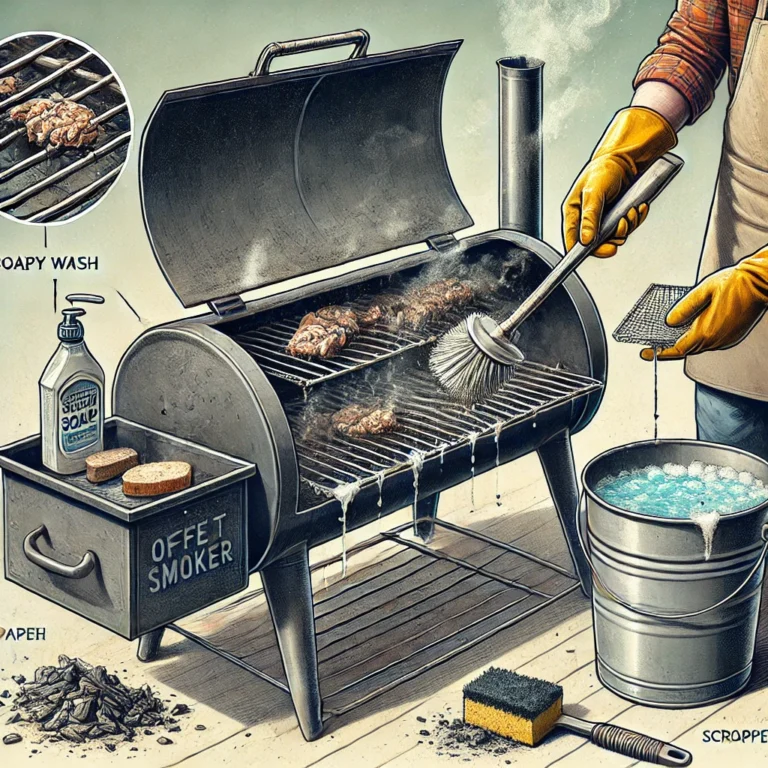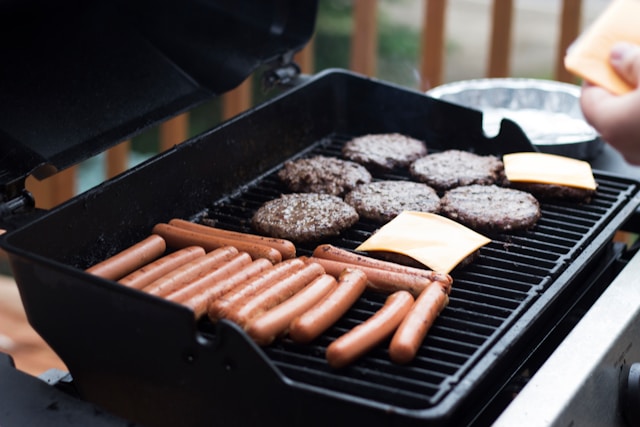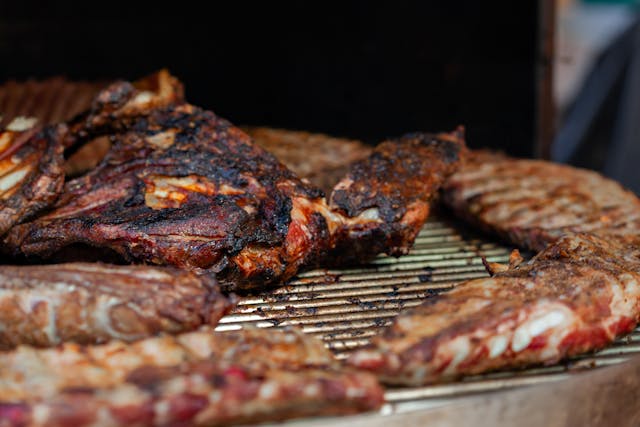“Master the Art of Smoking a Juicy Pork Shoulder on an Offset Smoker in 15 Simple Steps!”
Smoking a juicy pork shoulder is one of the most rewarding experiences in barbecue. Known for its rich flavor and tenderness, pork shoulder, when cooked low and slow on an offset smoker, transforms into pulled pork perfection. However, mastering this technique requires some patience and knowledge of your smoker. In this guide, we’ll walk you through every step, from selecting the perfect pork shoulder to achieving the desired smoky flavor, and offer detailed tips for ensuring a delicious result every time. An offset smoker offers a unique advantage in flavor and texture, thanks to its indirect cooking method. The firebox allows you to keep the heat source separate from the meat, resulting in slower, more even cooking that infuses the pork with rich smoke flavor. With the right temperature control, choice of wood, and careful monitoring, you can achieve melt-in-your-mouth tenderness with a smoky crust that’s simply irresistible. Whether you’re a beginner or an experienced pitmaster, this guide is designed to help you smoke the perfect pork shoulder using tried-and-true techniques.

1. Selecting the Right Smoking a juicy Pork Shoulder
Choosing the right cut is the first step to success. Pork shoulder can be sold as “Boston butt” or “picnic shoulder.” Look for a cut with a good amount of fat marbling, as this will keep the meat moist during the long smoking process. A bone-in pork shoulder is often preferred because it provides additional flavor and tenderness. Choose a pork shoulder that weighs between 6-10 pounds, as this size is ideal for smoking. Provides better flavor and easier monitoring of doneness.
2. Preparing the Pork Shoulder
Before smoking, it’s essential to properly prepare the pork shoulder. Trim any excess fat, leaving about a quarter-inch to protect the meat from drying out. If there’s a thick layer of fat cap, score it with a sharp knife to help the fat render during cooking. Trim down but don’t remove it entirely. Create shallow cuts to promote even fat rendering. Remove any unwanted silver skin or hard fat deposits.
3. Seasoning the Pork Shoulder
The seasoning is critical to adding flavor. A simple rub of salt, pepper, garlic powder, and paprika works well, but you can add other spices like cumin, brown sugar, or chili powder based on personal preference. Apply the rub generously and let it sit for at least 30 minutes or overnight in the fridge for deeper penetration. Salt, pepper, garlic powder, and paprika. Brown t.sugar for sweetness or cayenne for heat. Let the rub sit for at least 30 minutes, preferably overnigh
4. Setting Up Your Offset Smoker
Proper smoker setup is crucial for a successful cook. Start by lighting a chimney of charcoal and adding it to the firebox. Allow the smoker to preheat to around 225-250°F. Adding wood chunks to the firebox will generate the flavorful smoke you need for pork shoulder. Get the smoker to a steady 225-250°F. Use charcoal as the base and add wood chunks for smoke. Use hardwood like hickory or oak for robust flavor.
5. Choosing the Right Wood for Smoking
Wood choice greatly influences the flavor of your pork shoulder. For pork, stronger woods like hickory, oak, and pecan work best, providing a rich, deep smoke flavor. You can also mix in fruit woods like apple or cherry for a sweeter undertone. Stronger woods for bold smoke flavor. Apple or cherry adds sweetness. Use chunks for a slow burn and steady smoke.
6. Maintaining Temperature and Fire Control
Consistent temperature control is the key to a successful long smoke. Adjust the intake and exhaust dampers to maintain airflow and steady heat. Try to keep the smoker between 225°F and 250°F throughout the cook, adding small amounts of fuel to maintain heat. Keep between 225°F and 250°F. Adjust intake and exhaust for proper airflow. Add small amounts of charcoal or wood regularly to maintain heat.
7. Placing the Pork Shoulder on the Smoker
Once your smoker is ready, place the pork shoulder on the cooking grate, fat side up. Position it in the indirect heat zone, away from the firebox, to ensure it cooks slowly and evenly. Fat side up for self-basting. Keep away from direct flames for even cooking. Use the cooler part of the smoker for slow cooking.

8. Monitoring the Smoke and Meat Temperature
Throughout the cook, use a dual-probe thermometer to monitor both the smoker’s internal temperature and the pork shoulder’s internal temperature. You’re aiming for the meat to reach an internal temperature of 195-205°F for optimal tenderness. Ensure clean, blue smoke for the best flavor. Use a dual-probe to track both smoker and meat temps.
9. Spritzing and Mopping for Moisture
To keep the pork shoulder moist, spritz or mop it with a liquid like apple juice, cider vinegar, or a mixture of both every hour or two. This adds flavor and prevents the meat from drying out during the long cook. Apple juice or cider vinegar. Every 60-90 minutes during cooking. Keeps the meat moist and adds flavor.
10.The Stall: What It Is and How to Handle It
Around 160°F, the pork shoulder will hit the “stall,” where the internal temperature stops rising for a period due to moisture evaporating from the surface of the meat. This can last for hours but is completely normal. Some pitmasters choose to wrap the pork shoulder in foil (the “Texas Crutch”) to speed up the process. Choose to either wrap in foil or let it ride out. Expect the stall to last 1-2 hours.
11. Wrapping the Pork Shoulder (Optional Step)
Once the internal temperature hits about 160-170°F, you can choose to wrap the pork shoulder in foil or butcher paper. Wrapping helps push through the stall and retains moisture, but it can soften the bark. Foil retains more moisture, while butcher paper preserves the bark. Speeds up the cooking process by retaining heat.
12. Achieving the Perfect Bark
The “bark” is the dark, flavorful crust that forms on the outside of the pork shoulder as it smokes. To develop a good bark, avoid wrapping the meat too early and maintain consistent heat. A balance of moisture and dry heat will create the ideal texture. Comes from a combination of heat, seasoning, and smoke. Avoid wrapping too early to preserve bark. Keep consistent temperatures for an even crust.
13. Testing for Doneness
The bone should slide out easily, and the meat should pull apart with minimal effort. Use a probe to test for tenderness; it should slide in and out with no resistance.
14. Resting the Pork Shoulder
After smoking, it’s crucial to let the pork shoulder rest for at least 30-60 minutes. Wrap in foil and place in a cooler for longer rests. Prevents juices from spilling out when shredded.
15. Shredding and Serving
Once rested, shred the pork using two forks or meat claws. The meat should pull apart easily into juicy, tender strands. Serve with barbecue sauce, on buns, or alongside classic sides like coleslaw and cornbread. Use forks or meat claws to pull the meat apart.On buns, with sauce, or classic sides. Freeze leftovers in airtight containers for later

Freequently Asked Questions
2. Should I wrap my pork shoulder during the cooking?
It is not required to wrap your pork shoulder, sometimes referred to as the "Texas Crutch." When the beef reaches 160–170°F, it may be pushed through the stall and kept wet by wrapping it in foil or butcher paper. Wrapping, though, could make the bark softer. This stage may be skipped if you like a crunchier bark.
3. What’s the best wood to use for smoking pork shoulder?
Because they provide a robust, deep smoke taste, hardwoods like hickory, oak, and pecan are perfect for smoking pork shoulder. For a softer, sweeter smoke, you may also add fruit woods like apple or cherry. Steer clear of softwoods like pine or cedar since they have unpleasant, harsh tastes.
4. How do I know when the pork shoulder is done?
When the pork shoulder feels soft and reaches an internal temperature of 195 to 205°F, it is done. A probe should implant with minimal resistance, and the bone should flow out with ease. This indicates that the flesh is juicy and pull-apart since the connective tissues have broken down.
Conclusion
Smoking pork shoulder on an offset smoker is a rewarding experience that results in rich, flavorful barbecue with a perfect balance of smoky goodness and tender meat. While the process can be time-consuming, careful attention to detail—whether it’s in maintaining the right temperature, choosing the ideal wood, or patiently waiting through the stall—ensures that the effort is well worth it. By following the steps in this guide, you’ll gain confidence in handling your smoker and cooking the pork shoulder to perfection. The beauty of smoking pork shoulder lies in the transformation of a tough cut into something juicy, tender, and packed with flavor. Through the slow cooking process, the meat absorbs the smoke while becoming soft enough to shred easily. With proper seasoning, a good rub, and the right smoking techniques, you’ll impress your family and friends with mouthwatering pulled pork that can be served in a variety of ways.







